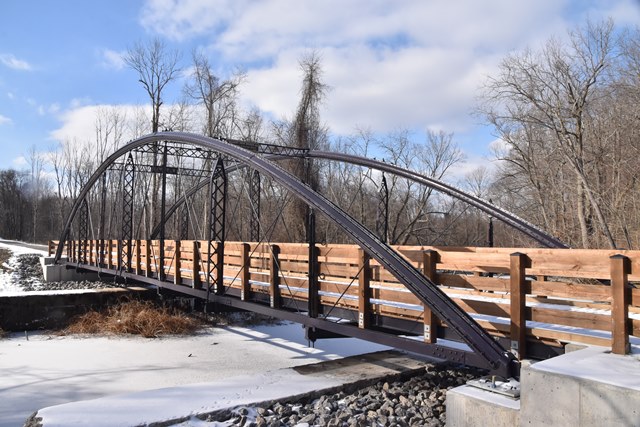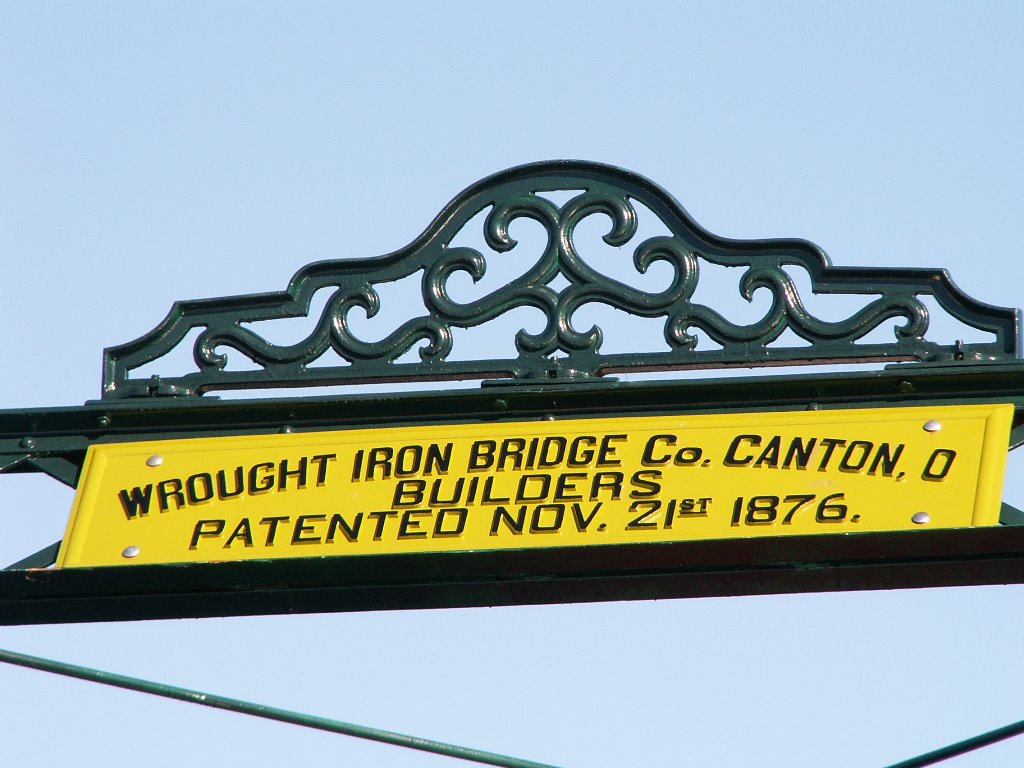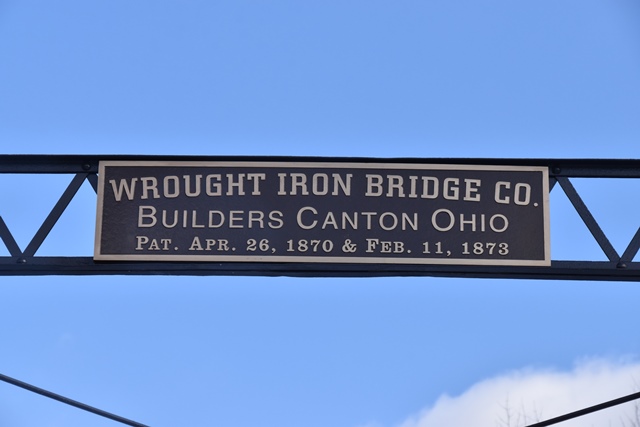We Recommend:
Bach Steel - Experts at historic truss bridge restoration.
BridgeHunter.com Phase 1 is released to the public! - Visit Now
Messerall Road Bridge
Pymatuning State Park Trail Bridge

Primary Photographer(s): Nathan Holth
Bridge Documented: February 1, 2023
Rural: Crawford County, Pennsylvania: United States
1876 By Builder/Contractor: Wrought Iron Bridge Company of Canton, Ohio
2022
99.0 Feet (30.2 Meters)
103.0 Feet (31.4 Meters)
14.8 Feet (4.51 Meters)
1 Main Span(s)
207214099330200

View Information About HSR Ratings
Bridge Documentation
This bridge was relocated here and preserved for vehicular use. Please also see HistoricBridges.org's page for photos and documentation of the bridge in its previous location.
Please see the original page for this bridge to learn more about its history and design.
This webpage was originally intended to be a celebration of this beautiful historic bridge's preservation and reuse on a non-motorized trail for the enjoyment of the general public. But in the interest of informing future bridge projects elsewhere, a more serious and critical discussion is required. The Messerall Road Bridge, which sat abandoned for many years was one of the first bowstring truss bridges to be featured on HistoricBridges.org. It was hoped for many years that this long-forgotten bridge would find a preservation reuse and that is in fact what happened. Abandoned bridges with a high historic significance and an uncertain future were one of the reasons why HistoricBridges.org was created: to advocate for the preservation of historic bridges and to help spread the word on how these bridges make great candidates for relocation and reuse on non-motorized trails. The project to preserve this bridge was a major, hard fought victory, and came at a dear cost, being as the funds to save this bridge were mitigation for the loss of another historic bridge, the Cambridge Springs Bridge. Indeed, the author of this website wrote many letters to get SHPO and PennDOT to recogize the Cambridge Springs Bridge as a historic bridge since at the outset of the replacement project they claimed that bridge was not even historic! But once it was found historic, mitigatrion for demolition was required and that mitigation was the relocation and preservation of the Messerall Road Bridge. So the point of this story is to illustrate that not only was funding dedicated to save and preserve a really important historic bridge, but on top of that another historic bridge was sacrificed to help save this bridge. So what went wrong? Simple answer: The contractor and PennDOT oversight of that contractor.
PennDOT let the contract to a low bidder who failed to predict the challenge of replicating Keystone column sections in a true parabolic shape. A bid by Bach Steel (a company whose quality HistoricBridges.org stands by) who DID understand the challenge and proposed a working repair method was REJECTED due to not being low bidder. They even asked a public question during bidding about this, and priced the work accordingly yet they did not get the job because the work always goes to the lowest bidder even if the lowest bidder has no clue what they are doing! Instead the contract was let to a contractor who used a blacksmith in Ohio who was allowed to complete repairs of a very poor quality. The contract plans and specifications were clear for the restoration of this bridge. Deficiencies in the historic bridge were to be repaired and were to match the original design of the bridge. This is a bowstring bridge. Its top chord takes on the shape of a keystone column and forms a parabola. A bidding contractor should have immediately known that this would be a custom fabrication job. Keystone columns are not rolled anymore, and have to be manually fabricated, and as a parabola the top chord would require custom bending. It is NOT polygonal. However the hired contractor for this bridge saw fit to splice new top chord sections in that were straight, and not curved at all! They used multiple short straight segments welded together, and even doing this they do not meet up properly with the original material. This was the first mistake. A contractor skilled in the work of restoring historic bowstring truss bridges would have had the steel curved to match the parabola of the bowstring top chord, matching the original 1870s craftsmanship. However the second mistake is that after the contractor made this imperfect repair: PennDOT allowed this! During a construction project, there is supposed to be an Engineer and/or inspector on-site who monitors the work of the contractor and if any problems or defects are noted, the Engineer and/or inspectors have the responsibilty to step in and direct the contractor to take corrective action. This was NOT done. This is mistake number two. And as if that was not enough, the icing on the cake is something so simple: The builder plaque. Create a copy of the existing plaque. Seems like a pretty simple directive for a contractor, right? Nope! The plaque on the bridge seen today is NOT a replica and it does not match the original design. While this might not seem like a big deal, if you understand the history of the Wrought Iron Bridge Company this matters. The early plaques used by the company did not include construction dates, they only listed the name of the company and a patent date. However, the style of the plaque changed over the years. The design of the plaque matters! It tells the history of the bridge and to a bridge historian the style of plaque is a clue to its age! The matter of replicating a plaque is simple, whether you use a mold to create an exact copy of the original plaque, or even someone with half a sense of design could at least arrange the letters in the style as seen on the original plaque using computer technology.
When HistoricBridges.org reported these problems, PennDOT went on the record saying the bridge (a fracture critical bridge with misaligned top chord sections!) could handle 90PSF and did not require correction. In other words, PennDOT thinks the bridge is fine! Take a look at the photos below and see if you agree with PennDOT.
It is frustrating to fight so hard and for so long to save a historic bridge only to have it become the victim of both a contractor who has no business working on a bridge of this design, and a Department that fails to monitor the work being done and ensure the work is being completed as specified in the plans. This narrative is intended to inform future preservation projects elsewhere. Use special provisions that require contractors to submit resumes showing the past bridges they have restored. And departments need to make sure they are getting the quality of work they are paying for. That is why this is so frustrating, because the money was spent, but the people did not recieve what they paid for which was a proper restoration of this historic bridge. Clearly, improvements need to be made in contractor selection for historic bridge preservation projects, and Department oversight of projects needs to be improved as well.
Above: This is the original, the proper plaque of the Messerall Road Bridge. It is the style the company used only in the 1870s. Note that Builders, Canton, Ohio are in the middle and have a stylized appearance.
Above: This is the next style of bridge plaque the company used. It started appearing ca. 1880.
Above: The false, incorrect plaque placed on the relocated Messerall Road Bridge. This arrangement was never used by the Wrought Iron Bridge Company.
This bridge is tagged with the following special condition(s): Unorganized Photos
![]()
Photo Galleries and Videos: Messerall Road Bridge
Unorganized Photos
Original / Full Size PhotosA collection of overview and detail photos, presented as an unorganized and unlabeled collage and gallery. This gallery offers photos in the highest available resolution and file size in a touch-friendly popup viewer.
Alternatively, Browse Without Using Viewer
![]()
Unorganized Photos
Mobile Optimized PhotosA collection of overview and detail photos, presented as an unorganized and unlabeled collage and gallery. This gallery features data-friendly, fast-loading photos in a touch-friendly popup viewer.
Alternatively, Browse Without Using Viewer
![]()
Maps and Links: Messerall Road Bridge
Coordinates (Latitude, Longitude):
Search For Additional Bridge Listings:
Bridgehunter.com: View listed bridges within 0.5 miles (0.8 kilometers) of this bridge.
Bridgehunter.com: View listed bridges within 10 miles (16 kilometers) of this bridge.
Additional Maps:
Google Streetview (If Available)
GeoHack (Additional Links and Coordinates)
Apple Maps (Via DuckDuckGo Search)
Apple Maps (Apple devices only)
Android: Open Location In Your Map or GPS App
Flickr Gallery (Find Nearby Photos)
Wikimedia Commons (Find Nearby Photos)
Directions Via Sygic For Android
Directions Via Sygic For iOS and Android Dolphin Browser
USGS National Map (United States Only)
Historical USGS Topo Maps (United States Only)
Historic Aerials (United States Only)
CalTopo Maps (United States Only)






